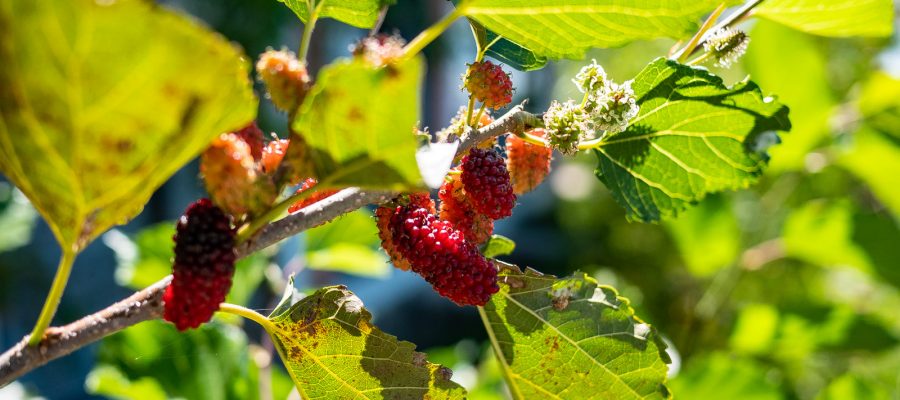Scientific Name: Morus
Bahasa Indonesia: Murbai
Batak: Murbe
Basic Information: Mulberry (or Morus) is a genus of flowering plants in the family Moraceae, which is comprised of 10-16 species of deciduous trees. Mulberries are fast growing when young, but soon become slow growing and rarely exceed 10-15 meters tall. These short-lived plants (with an economic lifespan of around 15 years) are usually small to medium sized shrubs or trees with a thick, tan-gray ridged trunk and light green leaves which vary in shape depending on the variety. The leaves are alternately arranged, simple and often lobed and serrated on the margin. The trees produce small green-yellow flowers in dense spikes and an oval aggregate fruit made up of individual drupelets. The mulberry fruit is a multiple fruit, approximately 2-3 cm long. Immature fruits are white, green, or pale yellow. In most species, the fruits turn pink and then red when ripening, and dark purple or black when fully ripe. Some species are also white when ripe, with a more mild sweet flavor than the darker fruits. Mulberries are widespread in southern Europe, the Middle East, northern Africa and Indian subcontinent but believed to originate from China.
Health Benefits:
- Aids in Digestion – mulberries contain dietary fiber which bulks up the stool and speeds up the movement of food through the digestive tract. This also helps reduce constipation, bloating, and cramping, and regulates cholesterol levels.
- Increases Circulation – high levels of iron significantly boost the production of red blood cells, which increases the distribution of oxygen to important tissues and organs, which in turn boosts metabolism and optimizes functionality of those systems.
- Regulates Blood Pressure – Resveratrol found in mulberries relax the blood vessels and reduces the chance of blood clot formation, strokes, and heart attacks.
- Anti-Cancer Potential – high levels of vitamin C, vitamin A, antioxidants, anthocyanins, and various other compounds are the main line of defense against some dangerous by-products of cellular metabolism, which can cause healthy cells damage turning them into cancerous ones.
- Improves Vision – zeaxanthin helps reduce oxidative stress on ocular cells and prevents certain damage to the retina.
- Reduces Inflammation – mulberry leaves are said to have anti-inflammatory properties, which prevent chronic diseases and can be used to reduce inflammatory pain.
- Boosts Immunity – the amount of vitamin C found in mulberries is almost the entire requirement for the day. This combined with the other vitamins and minerals help immunity levels.
- Builds Healthy Bones – Vitamin K, calcium, and iron found in mulberries are beneficial to the creation and maintenance of bone tissue.
- Reduces Bad Cholesterol – mulberry leaf powder and tea can reduce cholesterol levels and prevent atherosclerosis, heart attacks, and strokes.
- Prevents Premature Aging – high levels of vitamin A and E, along with other nutrients act as antioxidants that specifically affect the skin, tissue, hair, and other areas of the body where free radicals strike.
Fun Facts:
- Black mulberry was imported to Britain in the 17th century in the hope that it would be useful in the cultivation of silkworms. It was also used in folk medicine, especially in the treatment of ringworm
- Mulberry trees were well known in the ancient civilizations of the world. More specifically, mulberries were popular with the ancient Greeks and the fruit was dedicated to the goddess of wisdom, Minerva.
- Vincent Van Gogh featured the mulberry tree in some of his paintings, including one named Mulberry Tree, which he painted after a stay at an asylum
Sources:
https://en.wikipedia.org/wiki/Morus_(plant)
https://plantvillage.psu.edu/topics/mulberry/infos
https://www.organicfacts.net/health-benefits/fruit/mulberries.html

